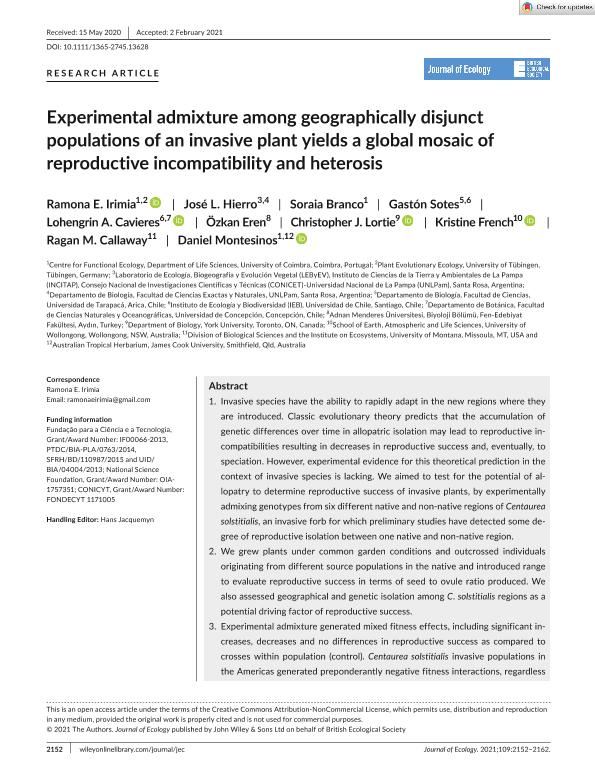Artículo
Experimental admixture among geographically disjunct populations of an invasive plant yields a global mosaic of reproductive incompatibility and heterosis
Irimia, Ramona E.; Hierro, Jose Luis ; Branco, Soraia; Sotes, Gastón Javier
; Branco, Soraia; Sotes, Gastón Javier ; Cavieres, Lohengrin A.; Eren, Ozkan; Lortie, Christopher J.; French, Kristine; Callaway, Ragan M.; Montesinos, Daniel
; Cavieres, Lohengrin A.; Eren, Ozkan; Lortie, Christopher J.; French, Kristine; Callaway, Ragan M.; Montesinos, Daniel
 ; Branco, Soraia; Sotes, Gastón Javier
; Branco, Soraia; Sotes, Gastón Javier ; Cavieres, Lohengrin A.; Eren, Ozkan; Lortie, Christopher J.; French, Kristine; Callaway, Ragan M.; Montesinos, Daniel
; Cavieres, Lohengrin A.; Eren, Ozkan; Lortie, Christopher J.; French, Kristine; Callaway, Ragan M.; Montesinos, Daniel
Fecha de publicación:
02/2021
Editorial:
Wiley Blackwell Publishing, Inc
Revista:
Journal of Ecology
ISSN:
0022-0477
Idioma:
Inglés
Tipo de recurso:
Artículo publicado
Clasificación temática:
Resumen
Invasive species have the ability to rapidly adapt in the new regions where they are introduced. Classic evolutionary theory predicts that the accumulation of genetic differences over time in allopatric isolation may lead to reproductive incompatibilities resulting in decreases in reproductive success and, eventually, to speciation. However, experimental evidence for this theoretical prediction in the context of invasive species is lacking. We aimed to test for the potential of allopatry to determine reproductive success of invasive plants, by experimentally admixing genotypes from six different native and non-native regions of Centaurea solstitialis, an invasive forb for which preliminary studies have detected some degree of reproductive isolation between one native and non-native region. We grew plants under common garden conditions and outcrossed individuals originating from different source populations in the native and introduced range to evaluate reproductive success in terms of seed to ovule ratio produced. We also assessed geographical and genetic isolation among C. solstitialis regions as a potential driving factor of reproductive success. Experimental admixture generated mixed fitness effects, including significant increases, decreases and no differences in reproductive success as compared to crosses within population (control). Centaurea solstitialis invasive populations in the Americas generated preponderantly negative fitness interactions, regardless of the pollen source, suggesting selection against immigrants and reinforcement. Other non-native populations (Australia) as well as individuals from the native range of Spain demonstrated an increase in fitness for between-region crosses, indicating inbreeding. These differences show an asymmetrical response to inter-regional gene flow, but no evidence of isolation by distance. Synthesis. The speed of adaptation and the accumulation of reproductive incompatibilities among allopatric populations of invasive species might be more rapid than previously assumed. Our data show a global mosaic of reproductive outputs, showcasing an array of evolutionary processes unfolding during colonization at large biogeographical scales.
Archivos asociados
Licencia
Identificadores
Colecciones
Articulos(INCITAP)
Articulos de INST.D/CS D/L/TIERRA Y AMBIENTALES D/L/PAMPA
Articulos de INST.D/CS D/L/TIERRA Y AMBIENTALES D/L/PAMPA
Citación
Irimia, Ramona E.; Hierro, Jose Luis; Branco, Soraia; Sotes, Gastón Javier; Cavieres, Lohengrin A.; et al.; Experimental admixture among geographically disjunct populations of an invasive plant yields a global mosaic of reproductive incompatibility and heterosis; Wiley Blackwell Publishing, Inc; Journal of Ecology; 109; 5; 2-2021; 2152-2162
Compartir
Altmétricas



